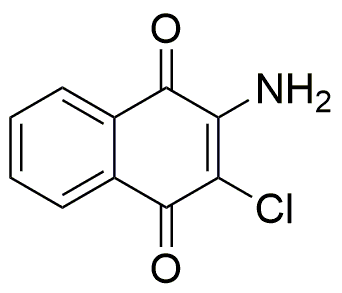2-Amino-3-chloro-1,4-naphthoquinone is widely utilized in research focused on:
- Pharmaceutical Development: This compound is a key intermediate in the synthesis of various pharmaceuticals, particularly in the development of anti-cancer agents due to its ability to inhibit certain enzymes involved in tumor growth.
- Dyes and Pigments: Its vibrant color properties make it useful in the production of dyes and pigments for textiles and inks, providing a stable and long-lasting color that is resistant to fading.
- Biochemical Research: The compound serves as a valuable reagent in biochemical assays, particularly in studies involving oxidative stress and cellular signaling pathways, helping researchers understand disease mechanisms.
- Electrochemical Applications: It is used in the development of electrochemical sensors, where its redox properties allow for the detection of various analytes, enhancing the sensitivity and specificity of the sensors.
- Environmental Monitoring: This chemical can be employed in environmental studies to detect and quantify pollutants, contributing to efforts in assessing and mitigating environmental contamination.
Información general
Propiedades
Seguridad y normativas
Aplicaciones
2-Amino-3-chloro-1,4-naphthoquinone is widely utilized in research focused on:
- Pharmaceutical Development: This compound is a key intermediate in the synthesis of various pharmaceuticals, particularly in the development of anti-cancer agents due to its ability to inhibit certain enzymes involved in tumor growth.
- Dyes and Pigments: Its vibrant color properties make it useful in the production of dyes and pigments for textiles and inks, providing a stable and long-lasting color that is resistant to fading.
- Biochemical Research: The compound serves as a valuable reagent in biochemical assays, particularly in studies involving oxidative stress and cellular signaling pathways, helping researchers understand disease mechanisms.
- Electrochemical Applications: It is used in the development of electrochemical sensors, where its redox properties allow for the detection of various analytes, enhancing the sensitivity and specificity of the sensors.
- Environmental Monitoring: This chemical can be employed in environmental studies to detect and quantify pollutants, contributing to efforts in assessing and mitigating environmental contamination.
Documentos
Hojas de datos de seguridad (HDS)
La SDS proporciona información de seguridad completa sobre la manipulación, el almacenamiento y la eliminación del producto.
Especificación del producto (PS)
La PS proporciona un desglose completo de las propiedades del producto, incluida la composición química, el estado físico, la pureza y los requisitos de almacenamiento. También detalla los rangos de calidad aceptables y las aplicaciones previstas del producto.
Certificados de análisis (COA)
Busque certificados de análisis (COA) ingresando el número de lote del producto. Los números de lote y de partida se pueden encontrar en la etiqueta de un producto después de las palabras "Lote" o "Lote".
Número de catálogo
Número de lote/lote
Certificados de origen (COO)
Este certificado de origen confirma el país en el que se fabricó el producto y también detalla los materiales y componentes utilizados en él y si se deriva de fuentes naturales, sintéticas u otras fuentes específicas. Este certificado puede ser necesario para cumplir con las normativas aduaneras, comerciales y regulatorias.
Número de catálogo
Número de lote/lote
Hojas de datos de seguridad (HDS)
La SDS proporciona información de seguridad completa sobre la manipulación, el almacenamiento y la eliminación del producto.
DownloadEspecificación del producto (PS)
La PS proporciona un desglose completo de las propiedades del producto, incluida la composición química, el estado físico, la pureza y los requisitos de almacenamiento. También detalla los rangos de calidad aceptables y las aplicaciones previstas del producto.
DownloadCertificados de análisis (COA)
Busque certificados de análisis (COA) ingresando el número de lote del producto. Los números de lote y de partida se pueden encontrar en la etiqueta de un producto después de las palabras "Lote" o "Lote".
Número de catálogo
Número de lote/lote
Certificados de origen (COO)
Este certificado de origen confirma el país en el que se fabricó el producto y también detalla los materiales y componentes utilizados en él y si se deriva de fuentes naturales, sintéticas u otras fuentes específicas. Este certificado puede ser necesario para cumplir con las normativas aduaneras, comerciales y regulatorias.


